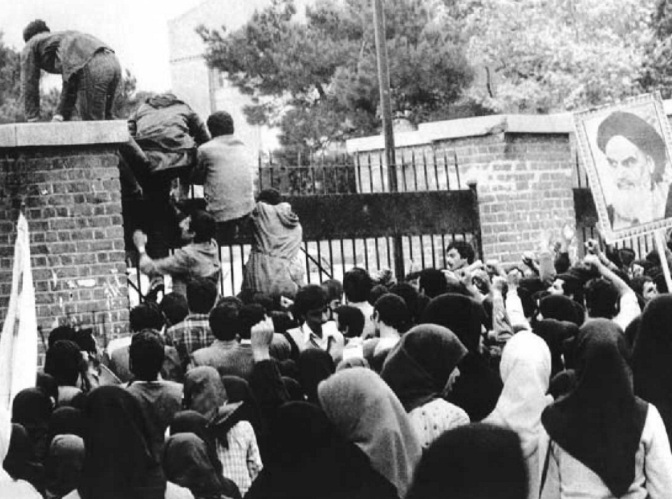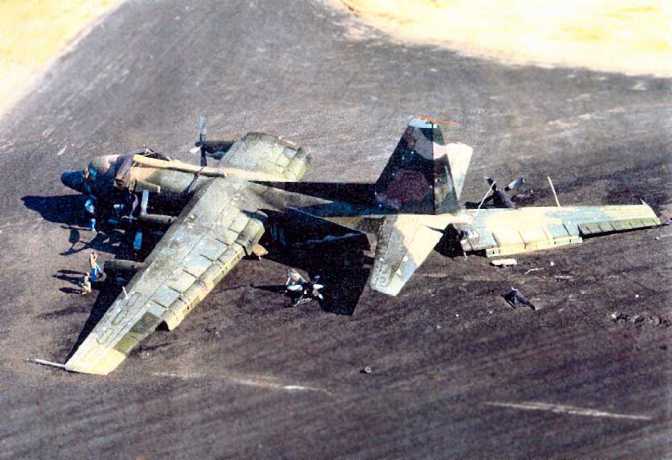The early hours of November 4th, 1979 found US Marines guarding the American embassy in Tehran on edge. Armed with M-16A1 rifles and M1911 pistols, they anticipated action outside the embassy’s gates, where students motivated by the revolution which had taken place earlier in the year had amassed in angry mobs. Unbeknownst to the Marine guards was the fact that on this day, the mob that had gathered outside was carefully briefed and primed to charge through the embassy’s gates and over its walls, storming the compound and overwhelming the small defense force tasked with safeguarding the embassy’s staff. The captors defaced the walls of the embassy, showing off the fifty two hostages they had taken on internationally-televised broadcasts, repeating demands for the recently-exiled Shah to return to Iran.
America was outraged.

The US military’s top brass, including Major General James Vaught and Colonel Charles Beckwith, were brought together to come up with a rescue solution using the very best military resources the country had to offer. This included Beckwith’s outfit, 1st SFOD-D, more popularly known as Delta Force. This top secret special missions unit would supply highly-trained and extremely deadly “operators” to carry out the actual rescue. US Air Force, Navy and Marine Corps aerial units would provide transportation, top cover and refueling, in order to get the operators into Iran and out with the hostages to safety in record time. The mission would be called Operation Eagle Claw, with Vaught taking overall command, and the Central Intelligence Agency contributing its own black operations specialists to help coordinate the rescue efforts.
All went according to plan in April, 1980, when President Jimmy Carter gave the go-ahead for Eagle Claw. That is, up till Mother Nature decided to throw a monkey wrench into the gears of the operation. A sandstorm at a forward refueling point necessitated a mission-abort. There was no way the team could carry forward with the rescue and ensure its success in those conditions. During the pullout from Desert One, the refueling point, tragedy struck. An RH-53 Sea Stallion, during a hover taxi, accidentally drifted into a parked EC-130 Hercules. The resulting explosion immediately killed five USAF aircrew, and three Marines in the RH-53.
Eagle Claw was a gross failure.

A newer plan was needed to rescue the hostages, and all ideas were accepted. One theory stood out in particular amongst the others- a highly focused objective to land tactical airlift aircraft inside Tehran, recover the hostages, and then fly out. The problem was that there was no space adequate enough for the US Air Force’s C-130s to land and take off once more, especially in close proximity to the embassy. At least that’s what everybody thought until someone noted a regulation-sized soccer field across the street from the embassy with a natural grass surface. Since the field couldn’t be elongated to support the landing and launching of the Hercules, the Air Force had to instead come up with a way to shorten the C-130’s landing and hasten its takeoff.
This new mission, known as Operation Credible Sport, would require tricky engineering and incredible airmanship from the pilots and aircrew involved. The US Army and CIA would find a way to insert Delta Force ninjas into Tehran and get them to the embassy, neutralizing any threats they encountered inside. They would then herd every hostage they could find (some were spread to other locations in the country as insurance) to the soccer field across the street- Amjadien Stadium, where the C-130 would be waiting with its engines running, cargo ramp down, and loadmasters scanning the bleachers and seating with CAR-15 carbines for targets of opportunity. As soon as the Herc was loaded up, it would take off and fly out to the Persian Gulf, escorted by US Navy fighter aircraft, where it would land on a waiting carrier; a feat previously accomplished with a Marine Corps C-130 in the early 1960s.

The Hercules was built with the ability to conduct STOL- Short Take Offs and Landings. However, by “short”, Lockheed originally meant less than 1000 yards, and not just 120 yards (the length of the Iranian soccer field). Hercs could be equipped with disposable rocket “bottles”, which attached to the rear sides of the fuselage and were activated on takeoff, drastically shortening the takeoff distance necessary for the aircraft to climb during its takeoff roll. The problem with RATO (Rocket-Assisted Take Off) launches is that they still needed a fair amount of runway before the bottles could be activated to help shoot the Herc into the sky.

In mid-1980, the US Air Force kicked off a development phase in secret at Wagner Field on Eglin Air Force Base, Florida. Coincidentally, Wagner was where Doolittle Raid pilots trained to fly before their famous mission in 1942. Similar to the Raid, Credible Sport would need its aircraft to take off in a far shorter distance than the plane was orignally designed for. Air Force security teams were beefed up and stationed around the base perimeter to ward off prying eyes. Three C-130s were brought over to Wagner and parked in closed hangars, scheduled for an extensive 90-day refit which would bring them to the XFC-130H configuration. If all went according to plan, two of the XFC-130Hs would be used during Credible Sport to rescue the Iranian hostages that same year.
To deal with the landing/takeoff situation, engineers modified the rocket engines from anti-submarine rocket missile systems (ASROC) and the AGM-45 Shrike anti-radiation missile and attached them to “rocket packs”, which would be placed at key points on the fuselage and nose section, controlled by switches in the cockpit of the Herc. During landing, rockets at the front of the aircraft, and on its lower sides and undersides, would rotate out from their packs and fire, slowing the forward movement of the Herc to a near-stop. Rockets above the wheel wells would decrease the rate of descent significantly, allowing for a relatively cushioned landing. During takeoff, rockets on the sides and back of the aircraft would fire, hurling the fully-loaded Herc into the air, while rockets mounted to the wings of the airplane would help with yaw control. A tailhook was mated to the XFC-130H for the carrier landing, while a brand-new double-slotted flap setup was installed on the wings, along with larger ailerons and three additional fins for stability. Terrain following/terrain avoidance sensors were also installed, so that the Herc could operate successfully at lower altitudes during the airspace penetration phase of the mission. An updated navigational suite and countermeasures array were also included in the modifications list.

To clue you in on just how ridiculous this was, a C-130 isn’t designed to fly with such attachments that cause it to shoot off the ground at steep angles of attack, nor is it designed to land on a tiny soccer field in the middle of a stadium with walls surrounding it over nine storeys high. Lockheed didn’t build the Herc to do anything that Credible Sport asked of it, and yet, it somehow worked.
In October, the Air Force was ready to fly the first XFC-130H (serial no. 74-1683). Over a period of nine days, multiple flights were conducted using the rocket system. The first round of testing went swimmingly with the Herc using only 100 feet for its ground roll during takeoff, and attaining 300 feet after only 200 feet of forward movement combined. A mission test was slated for the end of the month, where the aircraft would be tested to the parameters of Credible Sport in full operational configuration. This would prove to be the undoing of the XFC-130H. Though the takeoff went well, the landing was a completely different story. The forward-facing deceleration packs fired, reducing 74-1683’s speed to nearly nothing. Stalling immediately, it dropped like a rock towards the runway. However, its descent-arresting rockets (the ones that would cushion the landing) failed to fire on time, causing an extremely hard landing and breaking apart the right wing between the number 3 and 4 engines. The fuselage, still moving along the runway, dragged along the wing which sparked a fire. Thankfully, crash teams reached the Herc soon after and extinguished the conflagration while the flight crew escaped the burning aircraft.
Reacting quickly, the Air Force saw no other option than to strip the carcass of the Herc for vital reusable components and then bury the aircraft somewhere around Wagner Field, ensuring the preservation of the program’s secrecy. The second Herc brought to the XFC-130H configuration (serial no. 74-1686) was rolled out and readied for delivery, but the Hostage Crisis ended in Iran soon afterward, upon US President Ronald Reagan assuming office. With its mission permanently scrubbed, 74-1686 was placed in the Credible Sport II program, which saw its use as a testbed for the Combat Talon II special operations Hercules. Eventually, it was retired and placed on display at the Museum of Aviation at Robins AFB, Georgia where you can see it today, minus its rocket packs. The third C-130 (serial no. 74-2065) was returned to an active Air Force squadron, and apparently still flies today with the 317th Airlift Group out of Dyess AFB, Texas.


I have deployed to this field several times in my Air Guard and Air Force Reserve for training on runway repairs from bomb damage. For the first three deployments the runway was cratered with ANFO to simulate bomb damage. After the all clear we started recovery activities. This was an extremely beneficial training activity from 1980 or so for many years.
LikeLike